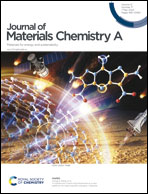Trace Cs induced phase transition of Mn2O3 for enhanced magnesium ion capacitors†
Abstract
The sluggish dynamics arising from potent electrostatic interaction between bivalent magnesium ions and the primary material hinder the reversible intercalation/deintercalation of Mg2+. This constraint limits the practicability of aqueous magnesium-ion energy storage devices. In this work, a straightforward approach to induce the phase transition from Mn2O3 to trace Cs induced Mn3O4 (CMO) using a small amount of Cs is presented for the first time. The newly formed phase not only expedites the diffusion of magnesium ions but also effectively increases the electrochemically active surface area (ECSA). Consequently, CMO demonstrates a specific capacity of 214.44 mA h g−1 at 0.1 A g−1, with the energy density of the capacitor employing CMO as the cathode amounting to 124.91 W h kg−1. The introduction of trace elements can establish a highly stable structure that effectively regulates charge transfer, which is more conducive to achieving highly reversible magnesium storage reactions. Additionally, the phase-transformed CMO phase effectively mitigates side reactions between the electrolyte and the electrode, enhancing its long cycle life. This study furnishes an effective strategy for the structural engineering of transition metal oxides, facilitating the induction of phase transitions through trace element incorporation and providing valuable insights for designing cathode materials endowed with high capacity and abundant electrochemical active sites.



 Please wait while we load your content...
Please wait while we load your content...